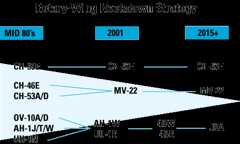

 10,000-poundexternal load, and deploying 2,100 nautical miles with a single aerialrefueling. The MV-22's rotor system and engine/transmission nacelle mountedon each wingtip allow it to operate as a helicopter for takeoff and landing.Once airborne, the nacelles rotate forward 90 degrees, converting the MV-22into a high altitude, fuel-efficient turboprop aircraft.
10,000-poundexternal load, and deploying 2,100 nautical miles with a single aerialrefueling. The MV-22's rotor system and engine/transmission nacelle mountedon each wingtip allow it to operate as a helicopter for takeoff and landing.Once airborne, the nacelles rotate forward 90 degrees, converting the MV-22into a high altitude, fuel-efficient turboprop aircraft.The program is currently in the Engineering and Manufacturing Developmentphase. The aircraft has completed Operational Assessment IIB, high/hothover performance trials, and has accrued over 1,100 flight hours withthe Full Scale Development and E&MD aircraft. The Osprey enters theDevelopmental Test/Operational Test phase in 1997; aircraft deliveriesto operating forces begin in 1999 and initial operational capability isscheduled for 2001.
The H-1 Upgrade program replaces the current two-bladed rotor systemson the UH-1N and AH-1W aircraft with a new, four-bladed, all-compositerotor system coupled with a sophisticated, fully integrated cockpit andstate-of-the-art technical enhancements. This 4BN/4BW remanufacture programreduces life-cycle costs, significantly improves operational capabilities,resolves existing safety deficiencies, and extends the service lives ofboth aircraft. Commonality between aircraft greatly enhances the maintainabilityand deployability of the systems with both aircraft supported and operatedwithin the same squadron structure.
 The CH-46E Sea Knighthelicopter is a day/night assault transport of combat troops, supplies,and equipment during amphibious landings and subsequent operations ashore.Additional tasks are evacuation operations and other maritime special operations;over-water search and rescue augmentation; support for mobile forward refuelingand rearming points; and aeromedical evacuation of casualties from thefield.
The CH-46E Sea Knighthelicopter is a day/night assault transport of combat troops, supplies,and equipment during amphibious landings and subsequent operations ashore.Additional tasks are evacuation operations and other maritime special operations;over-water search and rescue augmentation; support for mobile forward refuelingand rearming points; and aeromedical evacuation of casualties from thefield.Normal airframe operational and attrition rates have taken the CH-46force to the point where a medium lift replacement is required. Severalsafety and capability upgrades - interim measures to allow continued safeand effective operation of the Sea Knight fleet until its replacement bythe MV-22 - are currently in work, including: a dynamic component upgrade,a communication/navigation control system, Night Vision Goggle Head-UpDisplay (NVG HUD), GPS, and AN/ARC-210 radios.
 A more capable versionof the CH-53A introduced into the Marine Corps in 1966, the CH-53D SeaStallion is designed to transport equipment, supplies, and personnel duringthe assault phase of an amphibious operation and subsequent operationsashore. Capable of carrying supplies both internally and externally, theCH-53D is shipboard compatible and capable of operation in adverse weatherconditions both day and night. It can carry 37 passengers in its normalconfiguration and 55 passengers with centerline seats installed.
A more capable versionof the CH-53A introduced into the Marine Corps in 1966, the CH-53D SeaStallion is designed to transport equipment, supplies, and personnel duringthe assault phase of an amphibious operation and subsequent operationsashore. Capable of carrying supplies both internally and externally, theCH-53D is shipboard compatible and capable of operation in adverse weatherconditions both day and night. It can carry 37 passengers in its normalconfiguration and 55 passengers with centerline seats installed. The CH-53E is theMarine Corps heavy-lift helicopter. The aircraft is capable of lifting16 tons at sea level, transporting the load 50 nautical miles, and returning.The CH-53E can be refueled in flight, giving the helicopter a virtuallyindefinite range. The aircraft is compatible with most amphibious warships.It seats 37 passengers in its normal configuration and has provisions tocarry 55 passengers with centerline seats installed. The CH-53E Super Stallionprovides the MAGTF the capability to deliver heavy and outsized cargo,artillery, and light armor vehicles. It also provides a rapid combat resupplyopportunity when needed. Funded operational safety improvement programsfor the aircraft include GPS, AN/ARC-210 radios, and NVG HUD.
The CH-53E is theMarine Corps heavy-lift helicopter. The aircraft is capable of lifting16 tons at sea level, transporting the load 50 nautical miles, and returning.The CH-53E can be refueled in flight, giving the helicopter a virtuallyindefinite range. The aircraft is compatible with most amphibious warships.It seats 37 passengers in its normal configuration and has provisions tocarry 55 passengers with centerline seats installed. The CH-53E Super Stallionprovides the MAGTF the capability to deliver heavy and outsized cargo,artillery, and light armor vehicles. It also provides a rapid combat resupplyopportunity when needed. Funded operational safety improvement programsfor the aircraft include GPS, AN/ARC-210 radios, and NVG HUD.

